Have you been to an intertidal zone? If you look closely in pools of water that remained as the tide ebbs, there are interesting organisms living there. What intertidal zone animals do you expect to find?
Here is a list of some interesting ones – the remarkable baby animals of the intertidal zone.
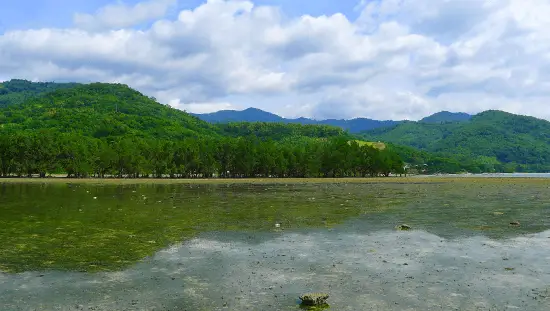
Which part of the coast is the intertidal zone?
As the name connotes, it is that part bounded by the highest tide and the lowest tide. This area can vary between places as the coasts have different configuration and slope. Those with steep inclines have smaller intertidal zone. It is here where people of the coastal communities derive sustenance when fishing in the deeper waters does not give them enough food for the day.
The intertidal zone is an interesting part of the coastal ecosystem. A rich biodiversity of life exists here, among which are the young stages of marine organisms.
Let me tour you through the intertidal zone by showing some of the common animals found in this important part of coastal ecosystem. A walk through the sandy and rocky shores can be an entertaining activity, as you will find a lot of interesting animals if you are keen enough to spot them.
Intertidal Zone Animals: 5 Babies
Here are the animals I’ve found in my short walk along the beach at low tide in a coastal area with an extensive intertidal zone. In one of my articles, I call them babies of the intertidal zone, as many of the marine organisms here are the early life stages of the mature ones.
If you are walking in the intertidal zone, be sure to exert a certain degree of caution to avoid stepping on the fragile marine animals of the intertidal zone. You might unwittingly disrupt the natural life processes going on in the ecosystem, as these animals play important roles in the maintenance of a healthy coastal ecosystem and in keeping them productive.
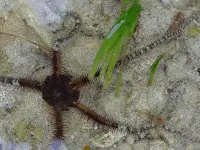
1. Baby Brittle Star
Brittle stars feed on almost anything its mouth and tentacles can handle. It is basically omnivorous, meaning, feeding on both small plants and animals. Along with the starfishes, the brittle stars prevent the excessive growth of algae in the coral reefs. Too much algae can suffocate corals and kill them.
The feeding habit of brittle stars prevents the buildup of organic materials in the benthic zone or the bottom part of the sea that includes everything solid such as sediments, rocks, coral fragments, mud, among others.
We also know brittle stars to feed on other animals without necessarily killing them. We refer this type of interaction to as mutualism – both organisms benefit from each other. The brittle star scavenges materials from the host organism, and it cleans the host up of excessive organic matter that can be harmful to its health.
The picture of the baby brittle star shown in the picture shows its approximate actual size. When handled, they easily disintegrate because the tentacles are very fragile. Brittle stars, however, can regenerate their tentacles easily.
2. Baby Eel
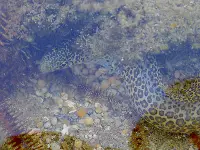
The baby eel is almost indiscernible behind an outcrop of dead coral and sand as the sun reflects light on the surface of the water. Its spotted skin renders it almost unrecognizable as it lies motionless and ready to escape once disturbed.
Eels form part of the intertidal zone food chain. Being predators, they control the population of their prey, thus achieve balance in the ecosystem. The specific food eaten by eels can be determined through a study of their stomach contents.
Eels are an important food source for man. In fact, a very important part of the diet and social interaction in some coastal communities when shared as part of tradition.[1]
3. Baby Lobster
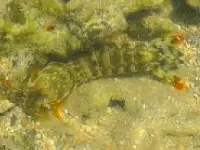
Just like the eel, this baby lobster referred to by locals as “pitik” finds refuge at the junction of a dead coral and sand. It does not really look like the mature one, but it grows into a lobster, according to the local guide.
Lobsters are essentially scavengers, meaning, they feed on particles of organic matter. Thus, it serves as a nutrient recycler in the coastal ecosystem. Other marine organisms feed on it as well as humans who find the lobster’s meat tasty.
Because of the high demand for lobster, its population has seen a decline in many tropical countries. Recently, lobsters served in restaurants are smaller. This shows an over-fished marine resource. Fishermen have harvested most of the mature ones.
4. Baby Sea Urchin
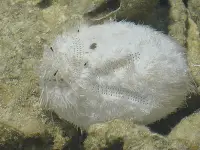
This baby sea urchin appears rather cute. It looks like a white tennis ball that floats about.

Some species of sea urchins are edible and can be consumed directly right after they are gathered. Some species are spiked and can cause discomfort when accidentally stepped upon (see right photo).
Just like the other marine organisms, sea urchins help maintain balance in the coastal ecosystem as part of the food chain. When left unchecked by predators such as starfishes, too many sea urchins can wipe out seaweeds and erode reefs. [2] This will change the productivity of the coastal zone reducing the capacity of the ecosystem to provide services such as provision of food and livelihood to resource dependent communities.
5. Baby Spider Conch
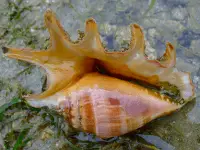
Spider conch, locally called “ranga-ranga,” is a favorite among gleaners. They are marine mollusks that graze on fine red algae [3] thus are also help achieve ecosystem balance.
Aside from consuming this mollusk as food, the shells are used for making shell craft. As a result, their population continues to decline over the years. If this situation persists for a long time because of unregulated harvesting, the cascading effects on the coastal ecosystem will be sustained. Nobody knows what that will be, and research will provide the answers.
The above featured marine organisms are just selections from the diverse array of animals in the intertidal zone. When unfortunate events like oil spill occurs, these animals are certainly affected. Based on the ecological roles and economic importance of these organisms, you will appreciate how such events can prove disastrous to resource dependent communities in the coastal areas.
References
1. Kavanagh, S. (2011, May 30). “Eels were life to our people”: traditional ecological knowledge of eels as food, medicine, community and life among participants in the Mi’kmaq food and ceremonial fishery in Cape Breton, NS. Retrieved September 23, 2013, from http://www.integrativescience.ca/uploads/articles/2011May-Kavanagh-Integrative-Science-eels-Mikmaq-fisheries-aboriginal-ESAC.pdf
2. Dunlap, H. and T. Monaghan. (2008). Sea urchin. Retrieved September 23, 2013, from http://tolweb.org/treehouses/?treehouse_id=4881
3. Tan, R. (2008, September 12). Spider conch. Retrieved September 23, 2013, from http://www.wildsingapore.com/wildfacts/mollusca/gastropoda/strombidae/lambis.htm
© 2013 September 23 P. A. Regoniel | Updated January 22, 2023


